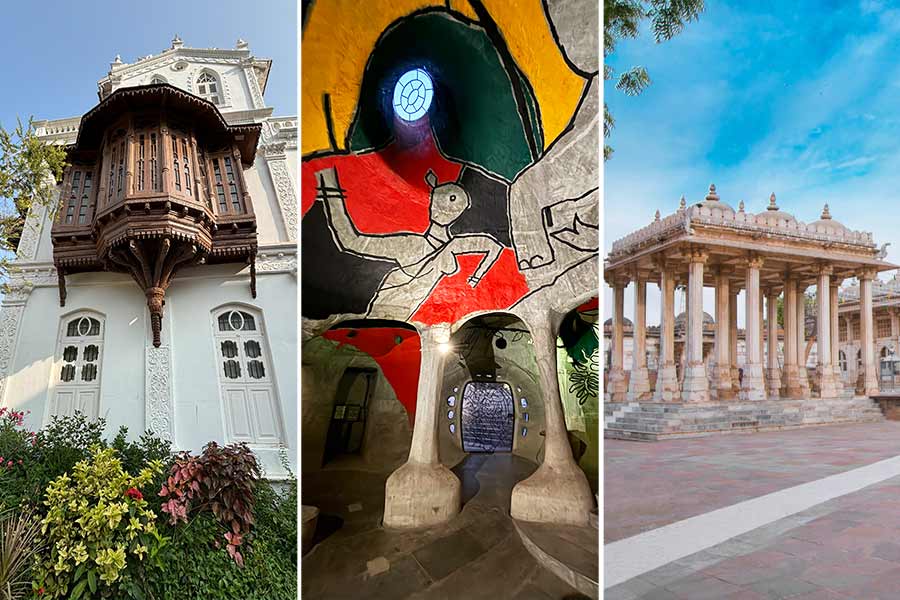Wooden havelis with elaborately carved pillars and frets, art deco gems, colonial and Victorian edifices, Indo-Saracenic mosques, and Hindu and Jain temples — the architecture of Ahmedabad is diverse. India’s first UNESCO Heritage City, Ahmedabad was established by Ahmed Shah 1411 AD shows off a potpourri of architectural influences. Indo-Saracenic architecture, where elements from Hindu, Muslim and colonial architecture are fused together, is in full play, alongside traditional havelis or townhouses with vernacular architectural elements like wood carved panels and brackets, organised in pols or clustered community dwellings.
Ahmedabad is also famous for its post-independence modernist architecture, from an era when rich textile mill owners commissioned architects like Louis Kahn and Le Corbusier to create a new architectural vocabulary for independent India.
The Le Corbusier magic
One of the first buildings that we visit in the city is the Mill Owners Association Building (ATMA) which was designed in 1954 by legendary Swiss-French architect Le Corbusier, who designed Chandigarh.
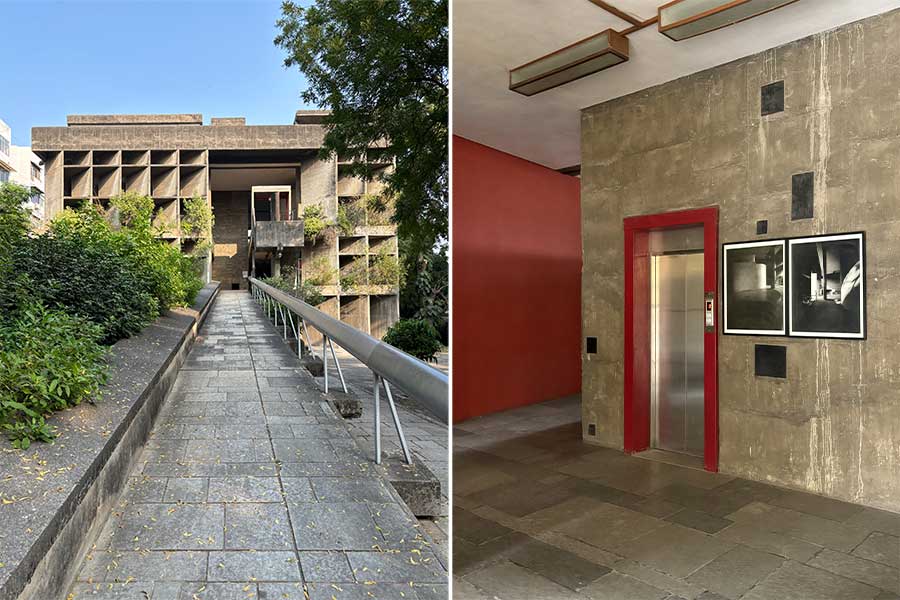
Inside the ATMA building designed by Le Corbusier
Taking cues from vernacular architecture with overhanging ledges and shade screens, it has a gently sloping ramp that leads you to the first floor with the brise soleil, oriented diagonally to obstruct views from the street and shade the building at the same time, allowing cool breeze to flow through it. The spaces between the sun screens are filled with lush greenery. Exposed plaster, a bright pop of red on walls, doors and elevators, and exposed bricks make the building the best of industrial chic. Langurs peer at us curiously from the greenery, as we climb the stairs to the conference room enclosed by a curved, brick wall paneled in wood veneer.
Stately homes

Divan's Bungalow, once a stately family mansion, is now a heritage hotel
My home away from home in the city is the 150-year-old stately Divan’s Bungalow in old Ahmedabad city. The ancestral home of the Kadri family who trace their origins to the city of Baghdad, it is now run as a heritage hotel by jüSTa Hotels and Resorts, With Corinthian capitals, gothic window frames, and jharokha windows with coloured glass, this mansion is a perfect example of the coming together of colonial and local architectural styles. With suites and rooms, a sitting room with blue chandeliers and teak wood furniture, a small verandah — with a swing — that opens out into a lush garden, cupboards filled with books and family portraits on walls, the building is a time warp into Ahmedabad of the past.
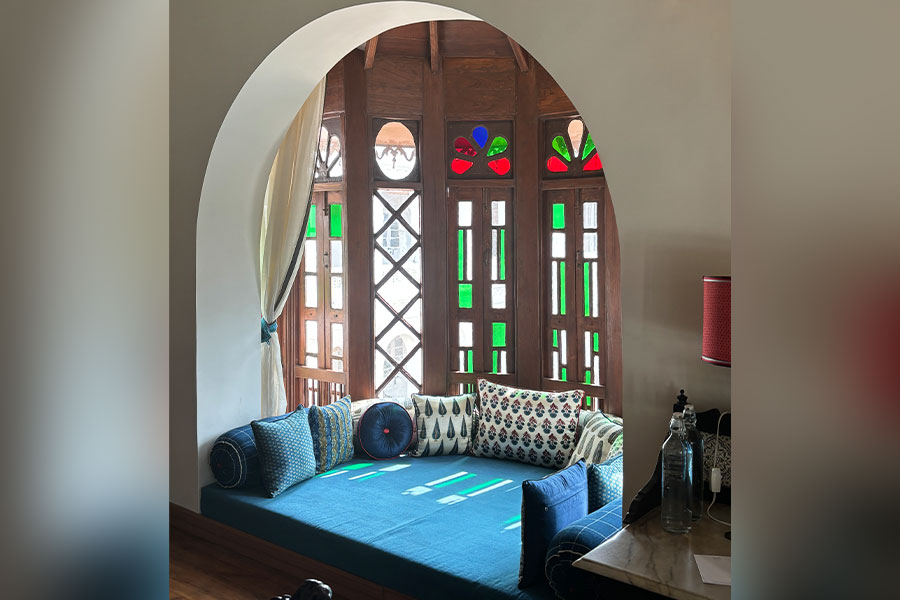
The nook on the inside of the 'jharokha' at Divan's Bungalow
I.M. Kadri, the nonagenarian architect with several famous buildings to his credit, fondly recalls spending his early years with his brothers in the nooks and corners of this bungalow built by his great grandfather. He remembers many prominent Congress leaders including Patel and Gandhi visited the home. The house had two separate wings, Zenana and Mardana, which were connected in the 1920s with suites. Serving local fare as well as special Mughlai influenced recipes from the family, with personalized service, it truly feels like an oasis in the old city.
The B.V. Doshi gems
Another inspiring space in the city is the sprawling campus of the Centre for Environmental Planning and Technology (CEPT) designed by legendary Ahmedabad architect B. V. Doshi. The structure is a series of studios raised above the ground with full height windows, large skylights and various brise soleil, and with exposed concrete and brickwork.The campus lined with neem trees, is buzzing with students putting up installations and exhibits and browsing the library, and I am blown away by ethereal quality of the spaces, especially when they are lit at night.

The CEPT campus by night
At the CEPT Archives, young archivist Saman Qureshi, takes us through the architectural history of the city, its design sensibilities and shows us the process of archiving the city’s architecture and digitising it.
B.V Doshi’s name is also associated with what is perhaps the most unconventional piece of architecture in the city. The Amdavad ni Gufa (which translates to Ahmedabad’s Cave), is a subterranean art gallery/exhibition space with ocular skylights and vivid paintings in bursts of colour that cover the domed ceiling and curved walls. A collaboration between architect Doshi and maverick artist M.F. Husain, the domes of this space were constructed with ferro cement and covered with mosaics to deflect the sunlight. Doshi was inspired by India’s ancient rock cut caves like Ajanta and Ellora and their spiritual vibe. Outside the gallery space is Zen Café, which is filled with young students when we sit down to revive with lemon cake and cold coffee.
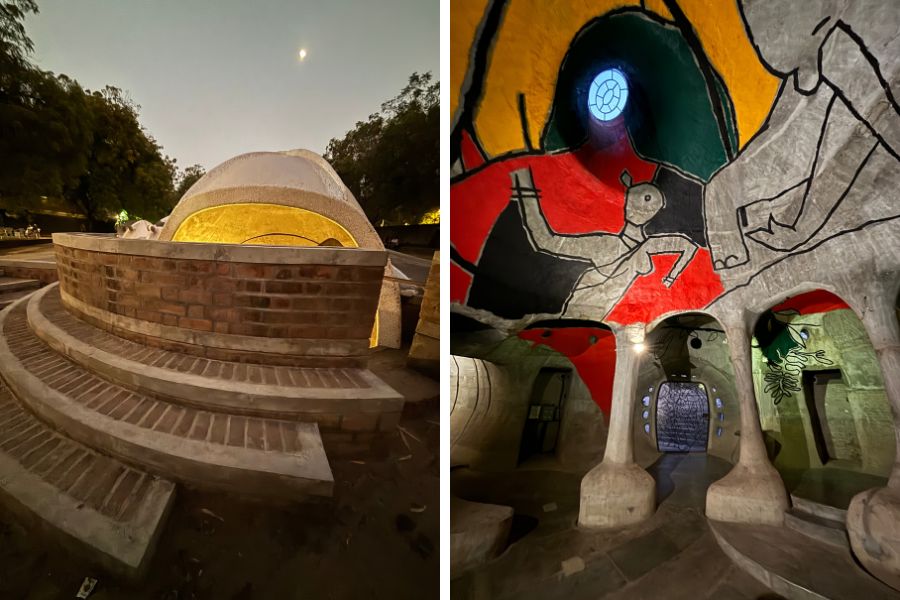
Artwork by M.F Husain adds a unique character to the whimsical Amdavad ni Gufa
Heritage highlights
Our heritage walk with veteran guide Mukarram Jonny Shaikh, takes us through the old city and its unique pols. These pols were cluster houses with a central courtyard connected by lanes and by-lanes and were designed to foster community living for people bound by strong social ties or professions. The architecture often incorporates elements like courtyards, overhanging balconies, and wooden jharokhas. The word pol is derived from the Sanskrit word pratoli, which means gate and these communities also had a gate, which was closed in the nights for security, and a guard posted at the gate.
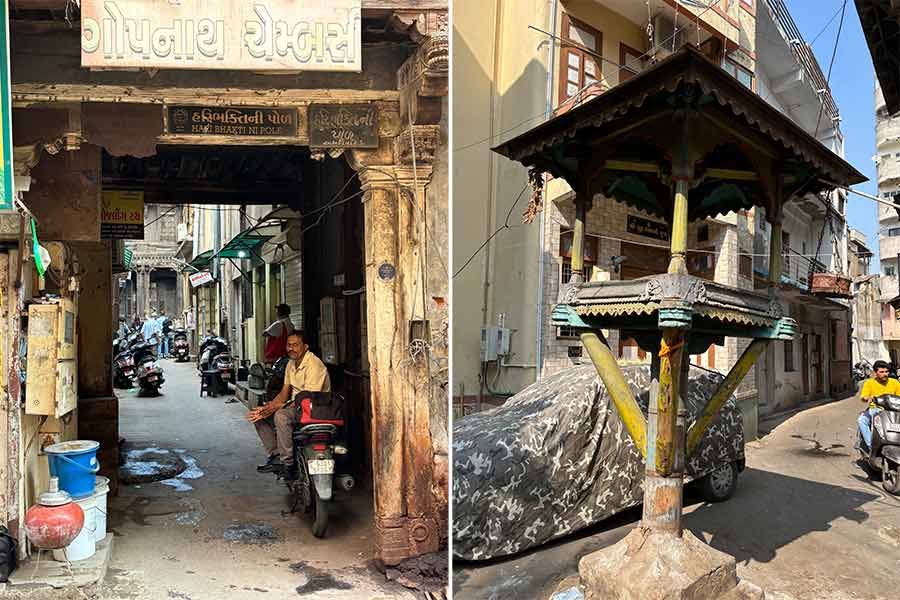
An old 'pol' gate and (right) a bird feeder in the central courtyard of a 'pol'
Another oft-found structure in the western state are stepwells or vav. Stepwells, usually five stories deep, once acted as the prime location for water storage in this arid state, and also doubled as recreational or gathering areas. Today, they are tourist attractions and Instagrammer’s delights.
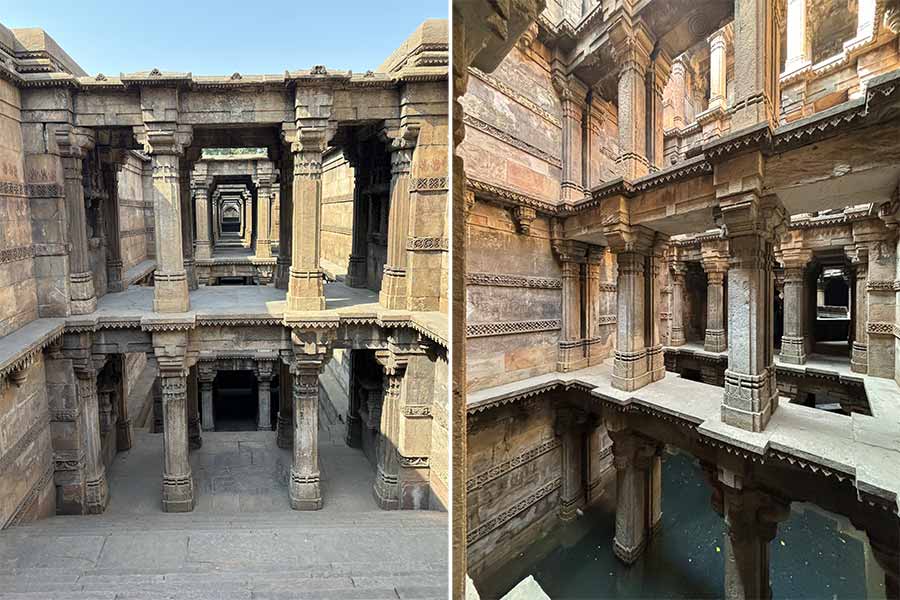
Dada Harir ni Vav was built by a midwife Bai Harir or Sultani Dai Harir
We visit the Dada Harir ni Vav, an octagonal sandstone stepwell in the Solanki style built by a midwife Bai Harir or Sultani Dai Harir, in 1485 during the reign of Mahmud Shah I Begra. Stepping into the vav is a sensory feast — feeling the air get cooler as you second, the play of light and shade, the carved vertical pillars and geometric friezes.
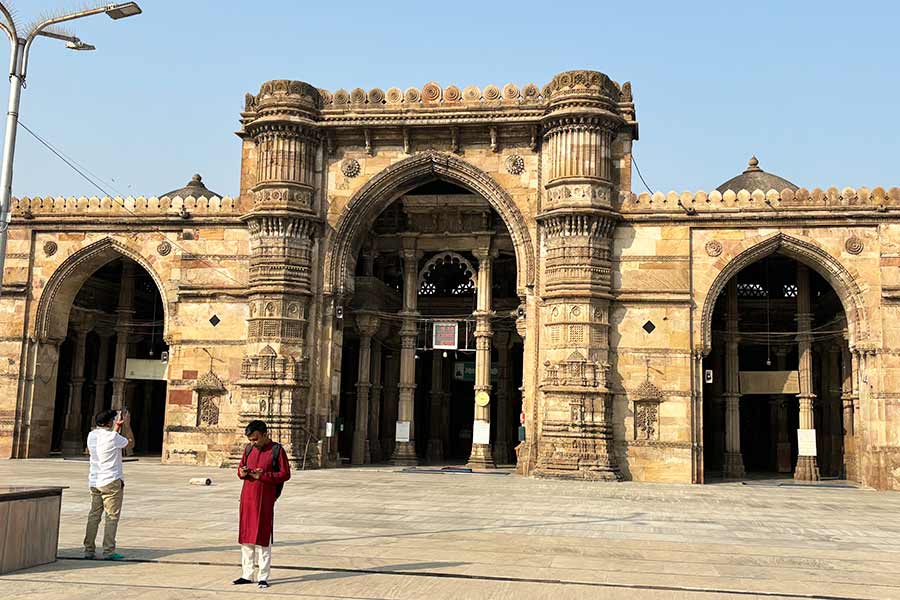
One of the gates of the Jama Masjid
Many of the heritage structures, especially the mosques and tombs are a fine example of Indo Saracenic architecture. Standing inside the complex of the Jama Masjid, built in 1424, and seeing the 260 carved pillars and 15 domes with motifs of lotus and kalash in the architecture, might remind you of the complexes a Hindu or Jain temple.
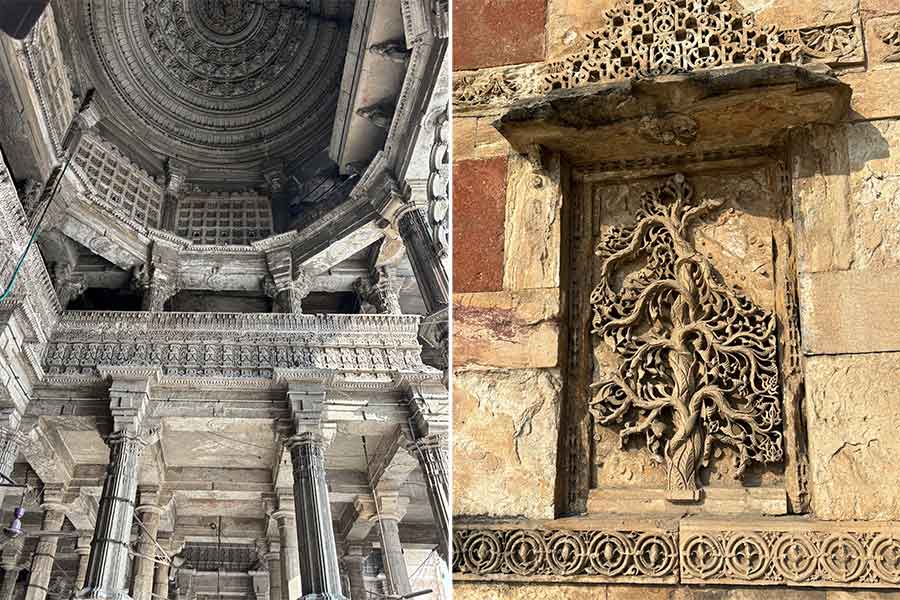
The inside of the curved dome and the etched pillars of Jama Masjid, and (right) a motif resembling the tree of life on the walls on the complex
One of my favourite buildings in the city is the Sidi Saiyyed Mosque, built in 1575 at the end of the Gujarat Sultanate. The yellow sandstone building has stunning jaalis or stone screens that remind me of fine lace.
Tombs and tales
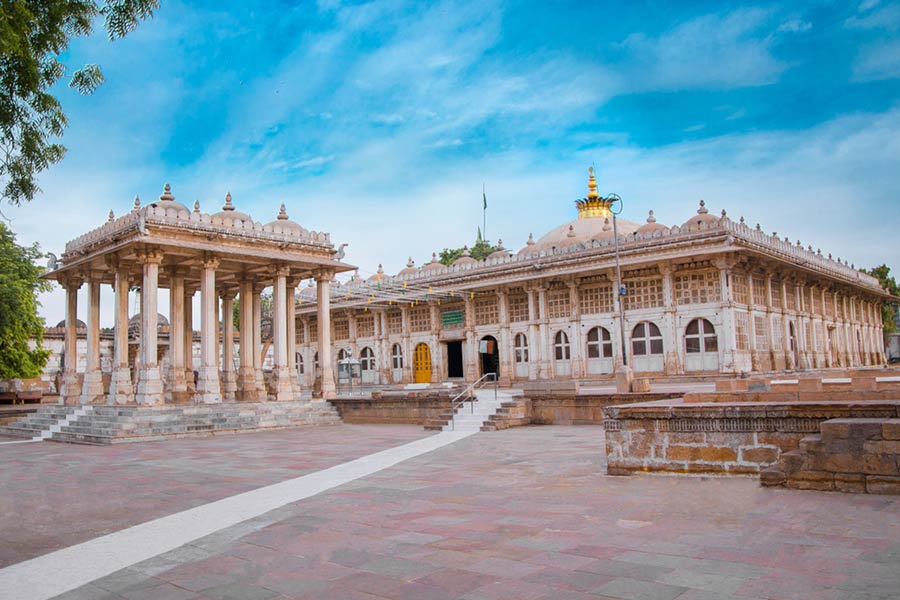
The Sarkhej Roza complex Shutterstock
One of the most architecturally stunning buildings is Sarkhej Roza in the outskirts of the city. The complex has a mosque, along with the king’s and queen’s palaces and tombs, including the tomb of Shaikh Ahmed Khattu Ganj Bakhsh, a friend and adviser of Ahmad Shah, who convinced the king to establish his capital on the banks of the Sabarmati River. The vast complex has white tombs, intricate stone jaalis and jharokas that give you a view of the surrounding lake, and many more such elements that make it an incredible place to visit for architecture lovers.

Amir and Sheru continue the tradition of playing music from the Naubat Khana
On my last night in the city, I head to the Naubat Khana — drum houses that once stood on the inside and outside of important structures like forts and from where announcements of the arrivals of royals and dignitaries were made. The Naubat Khana in Ahmedabad is above the tomb and mausoleum of Sultan Ahmed Khan, near the Jama Masjid’s east gate. Apart from announcing arrivals, musicians would play the drums from the Naubat Khana before the closing of the city gates.
I climb a steep stone staircase to see Amir and Sheru — descendants of the court musicians, who still play the drums and the shehnai at 11pm every night, continuing an unbroken tradition. Watching them play, the old and the new seem to come together seamlessly in this city with a rich history and heritage.
